Welcome to the October edition of Atlantic Transport News.
Here’s a look at what you’ll find in this edition:
- Record-breaking storm hits transportation services
- VIA “buffer car” order highlights desperate need for new fleet
- WestJet overseas plans for 2023 remain unclear
- MV Holiday Island to be scrapped
- Transit Cape Breton struggling to keep up with ridership growth
- Marine Atlantic marks sombre anniversary
RECORD-BREAKING STORM HITS TRANSPORTATION SERVICES
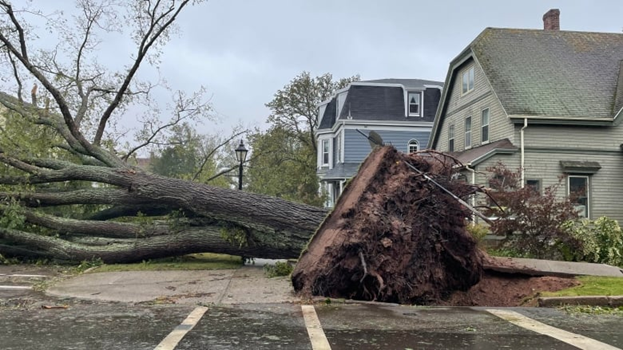
“Conditions are like nothing we’ve ever seen,” Charlottetown Police Services tweeted on the night of September 23-24, as hurricane Fiona smashed into Atlantic Canada, leaving a widespread swath of devastation stretching from southeast New Brunswick to the southwest corner of Newfoundland. That was probably an understatement. Fiona was indeed the storm of a lifetime, and its aftereffects will surely be felt for many months to come. In fact, many structures demolished by the high winds and heavy seas will likely never be rebuilt.
Transportation services throughout the region ground to a halt. On PEI, one of the hardest hit areas, both T3 Transit in Charlottetown and the Island Transit rural network remained shut down for a full four days. Mike Cassidy, owner of Coach Atlantic which operates both services under contract, said they realized early Saturday morning as the storm subsided that they “weren’t going anywhere”. Not only were streets and highways blocked by fallen trees and downed power lines, but there was a potential serious issue with refuelling their vehicles. With the power knocked out virtually everywhere, there would be no way to replenish when the gasoline or diesel on board was exhausted. On Monday, the third day after Fiona hit, he said there were lineups stretching two kilometres at the few fuel pump locations with power. It was Tuesday before scheduled transit service was resumed.
The intercity routes operated by Maritime Bus in Nova Scotia and New Brunswick were only out of action for one day, but the effects on the company’s charter business presented a much larger financial challenge. Numerous cruise ship visits and multi-day tours were thrown into chaos, resulting in a substantial hit to the company’s bottom line, Mr. Cassidy said, adding that the impact was severe throughout the tourism and hospitality industry – something it did not need as it struggles to recover from more than two years of COVID-induced losses.
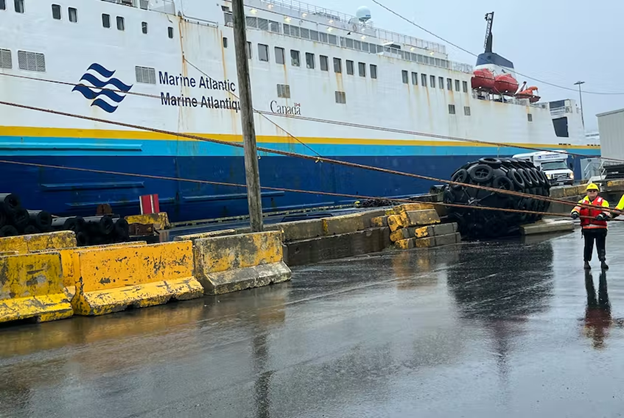
SUBMITTED PHOTO – Marine Atlantic
Another location lashed by the full fury of Fiona’s wrath was the ferry terminal town of Port aux Basques on Newfoundland’s southwest coast. Homes that had stood on the edge of the Cabot Strait for generations were washed away by the record storm surge. Two residents were carried away by gigantic waves, but one was miraculously rescued. Tragically the other was not. While iconic images of the devastation were seen around the world, the Marine Atlantic ferry terminal and the two vessels tied up there reported no significant damage. Company spokesperson Darrell Mercer said planning for the oncoming storm involved docking two vessels in both North Sydney and Port aux Basques, with extra mooring lines securing all four.
“We’re going to be losing a number of sailings this weekend,” he told Saltwire News. “We expect there’s going to be significant demand next week to travel, especially from a commercial perspective. So, having two vessels in each port will allow us to resume operations fairly quickly and move as much traffic as we can fairly quickly,” It was not until Sunday evening that normal schedules resumed. The storm forced cancellation of the final round trip of the season between North Sydney and Argentia.
Air service started returning to normal on Saturday, with no significant damage reported to airport infrastructure. VIA Rail cancelled its departures of the Ocean from both Halifax and Montreal on Friday, and when service resumed on Sunday there were substantial delays as power outages had knocked out numerous grade crossing warning signals, requiring manual protection of train movements.
-Ted Bartlett
VIA “BUFFER CARS” ORDER HIGHLIGHTS DESPERATE NEED FOR NEW FLEET
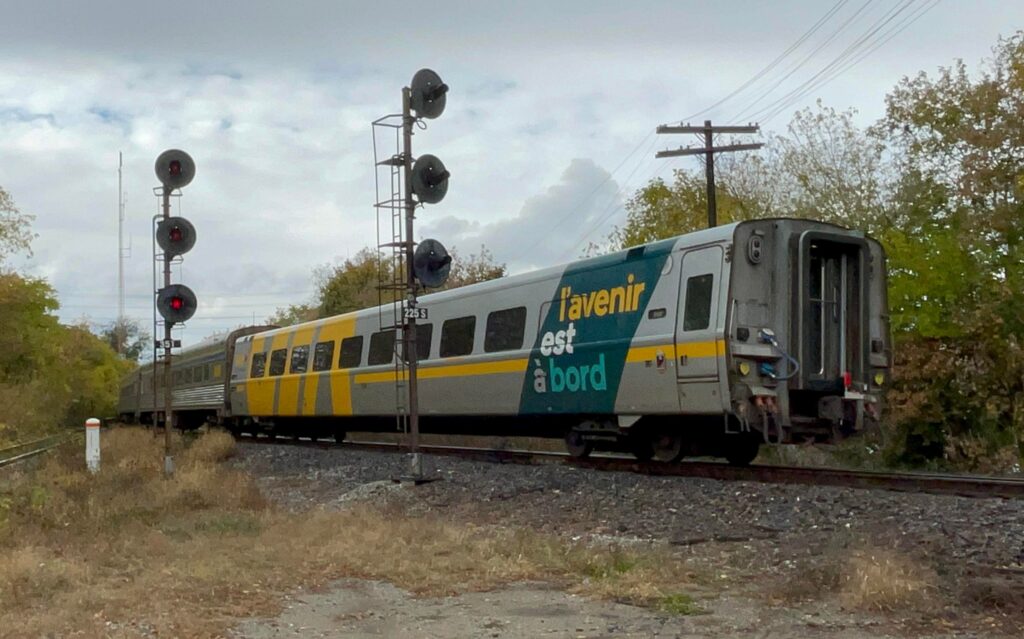
In what seemed to be a rather abrupt development, news broke last week of a new policy at VIA Rail – all trains operating with either HEP1 or HEP2 stainless steel equipment, cars built in the 1940s and 1950s by the Budd company and refurbished by VIA Rail, would be required to operate with “buffer” cars at either ends of the consist. Depending on the train, these may either be unoccupied HEP (“Head End Power”) cars, an unoccupied locomotive, or other equipment. It was not immediately clear what prompted this decision, but more news has been forthcoming in the days since, culminating with a ministerial order directing VIA Rail to operate with this practice until several tests are complete.
The origins of this operating change began in 2020, when structural deficiencies were discovered in several HEP cars during a rebuilding program. This resulted in the cancellation of a more comprehensive rebuild of 17 HEP1 coaches by Bombardier, and also prompted an immediate inspection of the entire HEP fleet. By chance, these inspections took place when nearly the entire fleet was sidelined due to the Covid-19 pandemic, allowing VIA to complete the work with minimal service disruptions. Following these inspections, VIA hired engineering consulting firm Hatch to prepare a more thorough inspection and report on the state of the equipment.
It was the completion of this report that prompted the sudden change in operating practices. While Hatch and VIA have deemed the cars safe to continue operating, the inspections raised serious concerns about the crashworthiness of the nearly 70-year old cars, and the buffer car solution has been implemented as a temporary measure while additional simulations, tear-down inspections, compression-testing, and repairs can be completed.
On October 19, Transport Canada published a ministerial order requiring that VIA implement this buffer practice (though it had already done so a week earlier), and further requiring an engineering simulation by the end of October; a tear-down inspection of four defective cars by January 31, 2023; compression tests on at least two unrepaired cars by January 31, 2023, with a report on how this will inform future repairs; a full report on these tests by March 31, 2023; and finally, a compression test on a fully repaired car to inform and validate the repair methodology, due by December 31, 2023. Presumably, successful tests should allow VIA to end the use of buffer cars, but it is not at all clear at which point in the process this might be allowed.
The immediate implications of this new policy will stretch fleet availability, as all HEP consists must be lengthened with the addition of buffers. In the case of the Canadian, a buffer car behind the Park car will be at least a minor inconvenience to passengers hoping to enjoy the view from the rear of the train. On the Skeena, the Jasper-Prince Rupert train, it seems that the Park car will simply be off limits to passengers instead of operating with a buffer. Baggage cars serving as head-end buffers will not be able to be occupied by crew during the trip, which has also resulted in VIA not allowing pets in baggage cars for the time being.
In the east, the current Ocean consist, despite all of its shortcomings, will be relatively immune to this change. The HEP end of the train is already bracketed by a baggage car at one end and Renaissance equipment at the other end, so the only operational change is the end of pets being allowed in the baggage car. Presumably, they could be accommodated in the Renaissance baggage car instead, but it is not at all clear if VIA is considering this. There may also be some limit on available equipment, particularly as consists need to expand around the holidays and into next summer, presuming this requirement remains in place for an extended period of time.
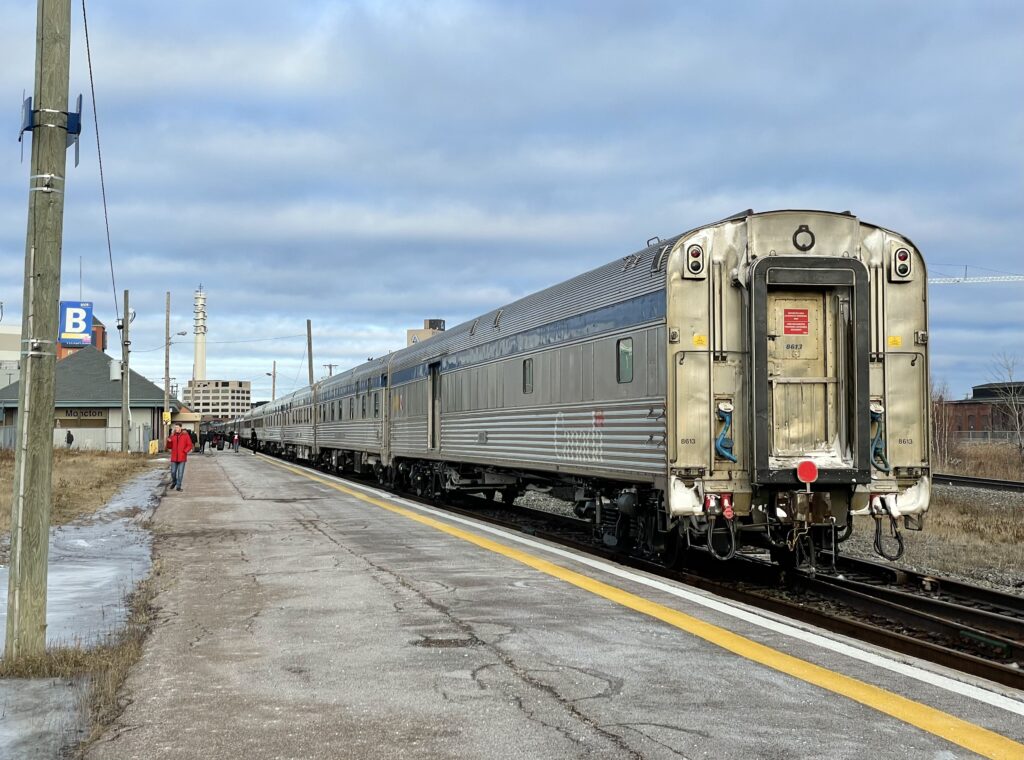
Beyond any of these temporary issues, the much more significant concern that this highlights is the ongoing deterioration of the HEP fleet, which remains the backbone of all VIA services outside the Corridor. New equipment from Siemens will replace the HEP2s and few HEP1s in the Corridor within a few years, but there is still no committed funding or order in place to replace the long distance fleet. To date, the only serious plan was to continue funding incremental refurbishments to try to keep the 70 year old cars hobbling along indefinitely. Now more than ever, it is readily apparent that their time is running out, and in the absence of a replacement order in the immediate near future, VIA may soon find itself with no choice but to shut down service to the majority of the country.
An order for new equipment should have been placed years ago, but absent the ability to step back in time, VIA needs to be authorized to proceed with a procurement process as soon as possible. A business case for a new long distance fleet has reportedly been prepared by VIA and submitted to Transport Canada for consideration; hopefully, this very public display of the dire state of the HEP fleet will help convince the government to let VIA move Canadians from coast to coast into the 21st century, not merely those between Windsor and Quebec City. Time is quickly running out.
-Tim Hayman
WESTJET OVERSEAS PLANS FOR 2023 REMAIN UNCLEAR
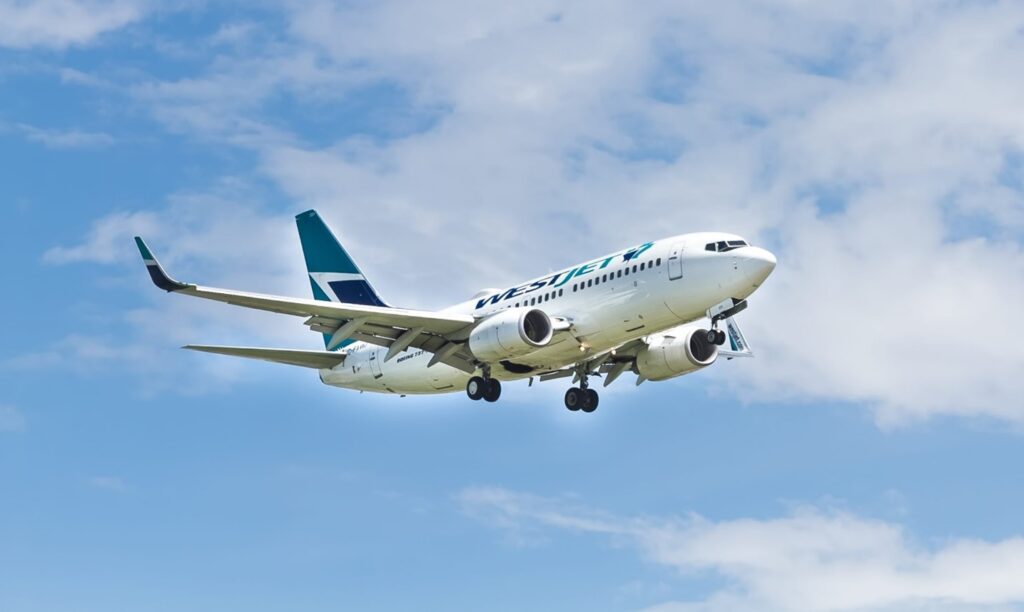
If you’ve been visiting WestJet’s website with an eye to booking a direct overseas flight from Halifax Stanfield International Airport next year and keep coming up empty-handed, apparently you shouldn’t give up just yet. The airport authority says it is still in discussions with WestJet about their 2023 summer season routes from YHZ.
“To our knowledge, no decisions have been made,” says spokesperson Tiffany Chase, “which is why you wouldn’t be able to see what will be available in the system yet. We hope there will be news on this in the next couple of weeks as they finalize their plans for next year.”
In previous years the Calgary-based airline has been offering direct flights from Halifax to London Gatwick, Paris, Dublin and Glasgow from May to October. Some of the schedules terminated earlier than planned in 2022, ostensibly due to operational issues such as crew shortages. But in June the company’s new CEO announced a major refocusing of their service offerings, which involve going back to their western Canada roots where they enjoy a substantial market share. Some industry analysts have expressed the view that WestJet has been less successful in competing with Air Canada in eastern and overseas markets, suggesting that they are essentially giving up fighting a war they cannot possibly win.
More recently, WestJet announced it would be suspending flights between Halifax and St. John’s for almost four months this coming winter and early spring. It’s believed to be the first time the airline has not offered service on that route since they first started flying in Atlantic Canada some 25 years ago. However, they evidently plan to reinstate the service beginning April 30, as online bookings are now being accepted for two return WestJet Encore Q400 flights daily between YHZ and YYT.
Also returning on the same date is service between Charlottetown and Toronto Pearson, initially four times per week but ramping up to daily in July. Interestingly, this restored service will feature Boeing 737 jets, as will a returning daily service between Sydney and YYZ beginning in August. There is no indication yet as to if or when the airline will restore service between Fredericton and Toronto. Service will continue through the winter on a reduced basis between Moncton and Pearson.
MV HOLIDAY ISLAND TO BE SCRAPPED
The MV Holiday Island, a veteran of the Caribou NS – Wood Islands PEI ferry crossing, has sailed for the last time. Three months following the dramatic fire and evacuation of the ferry on its July 22, 2022 crossing, Transport Canada has issued a tender for the disposal of the vessel. According to the posted tender, the successful bidder will have until November 30 to remove the vessel from its berth at Wood Islands, and until February 28, 2024 to complete the ship breaking (disposal) work.
The replacement for the 52-year old Holiday Island is already on order, but is not expected to be delivered until 2027. In the interim, Northumberland Ferries intends to continue with a 2-vessel service through some form of vessel lease, similar to the arrangement with Quebec’s Saaremaa I over the last few months of the 2022 season. It is not yet clear, however, whether there will be opportunity to continue a lease of the Saaremaa I, or if a different vessel will be brought in for the 2023 sailing season.
TRANSIT CAPE BRETON STRUGGLING TO KEEP UP WITH RIDSERSHIP GROWTH
Ridership increases are good news for any transit agency, but rapid ridership growth can result in capacity being unable to keep pace with demand. Such is the case with Cape Breton’s transit agency, which has seen ridership increase four-fold in the last 5 years. Much of the ridership growth has been tied to increased enrollment at Cape Breton University, thanks in large part to more international students coming to Cape Breton to study.
As CBC reports, riders are now frequently finding themselves left on the side of the road as full buses pass, unable to pick up more passengers. With buses running on a half-hour (or less frequent) schedule, full buses make the system increasingly difficult to use, and may leave some students seeking out cars or other options to get around.
The municipality is evidently aware of the issue and would like to add capacity to the bus fleet, but few buses are available to bring in on such a rapid timeframe. Further, funding for that sort of capital investment may be limited, particularly for conventional diesel buses. Cape Breton is investigating the viability of adding electric buses to the fleet, but that isn’t likely to proceed quickly enough to be able to address the current crunch.
MARINE ATLANTIC MARKS SOMBRE ANNIVERSARY
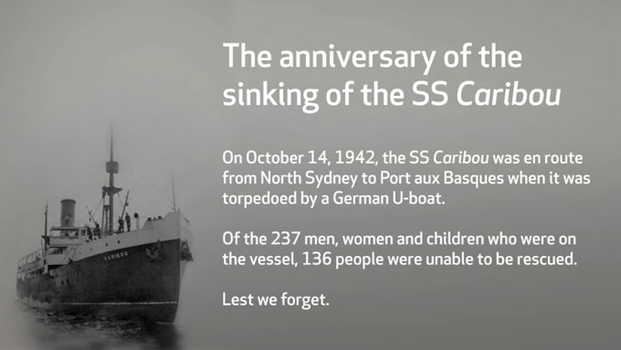
The harsh reality of the Battle of the Atlantic came home with a vengeance across Newfoundland on October 14, 1942. The Newfoundland Railway ferry SS Caribou had sailed from North Sydney at 2145 the previous evening. In the pre-dawn darkness, about 25 nautical miles from Port aux Basques, a torpedo fired from a German U-boat struck her amidships on the starboard side. The mortally wounded vessel sank in just five minutes, with only 101 survivors among the 237 passengers and crew on board. The dead included 31 of the ships officers and crew, 56 military personnel, and 48 civilain passengers.
Among those lost were veteran Captain Benjamin Taverner, and his two sons Stanley and Harold, both of whom were deck officers. Some 20 years after the tragedy, Canadian National, which had inherited the ferry operation upon Confederation in 1949, named a new coastal vessel Taverner in their honour. And when a new superferry, custom-designed for service between North Sydney and Port aux Basques, was being built in 1985, it was decided that she should bear the Caribou name. When the new flagship of the fleet made her maiden voyage in May 1986, all known survivors of the 1942 tragedy were invited along for the voyage. At daybreak, 25 miles from Port aux Basques, the superferry stopped, and one of the invited guests threw a wreath overboard at her namesake’s final resting place.
Lest we forget.
-Ted Bartlett





